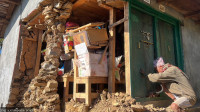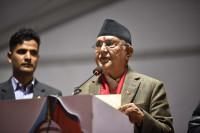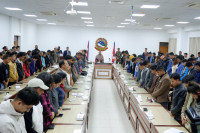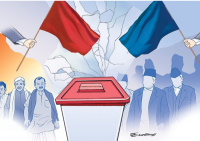Opinion
Impact of demonetisation
Why this issue was not raised during PM Oli’s state visit to India remains a mystery
On the eve of Prime Minister Oli’s recent state visit to New Delhi, sections of the Indian media reported that one of the items on the agenda was the issue of exchanging INR950 crore ($146 million) worth of demonetised Rs1,000 and Rs500 Indian currency (IC) notes remaining in Nepal. They cited Oli’s pre-departure address to Parliament as the basis of the report, but they did not say how and where they got the figure of IRs950 crore. Luckily, the ‘demon’ of demonetisation did not feature in the bilateral talks, and we were saved from knowing the scale of the problem faced by Nepal due to old Indian currency notes being pulled out of circulation.
Immediately after the demonetisation in November 2016, Nepal Rastra Bank declared that there was Rs33.6 million worth of demonetised banknotes in Nepal’s formal banking channels. Due to an open border and unregulated flow of people between the two countries, it can be expected that much larger sums are under informal possession inside Nepal. Since there are millions of Nepali workers in India who send remittance home and there is almost free convertibility of IC in Nepal, it is extremely difficult to estimate the amount of demonetised banknotes here. Estimates range as high as Rs3 billion to Rs100 billion.
Trapped with a lot of cash
The demonetisation in India has come as a double whammy to Nepal. One, prior to Indian Prime Minister Modi’s 2014 visit to Nepal, Rs1,000 and Rs500 denomination notes were banned in Nepal. Obviously, fewer notes of these denominations were in circulation and people were cautious about accepting them. They were banned primarily to control fake currency notes in Nepal. However, as a gesture of goodwill, Prime Minister Modi lifted the ban during his visit to Nepal. Nepalis were also allowed to freely exchange Indian currency up to Rs25,000 in Nepal. Within two years of the relaxation, the demonetisation policy was launched and Nepalis holding IC were trapped.
Two, during the 135-day unofficial blockade in 2015-16, demand for Indian currency swelled in the border areas as locals resorted to smuggling fuel and other supplies from India. Traders were caught by surprise when the notes were pulled out of circulation, and they were left with piles of the same. Indian writer Kanwaljeet Singh has blamed demonetisation as a factor behind the electoral victory of the left alliance in Nepal’s recent elections as it campaigned on an anti-India plank. If Singh’s assertion is true, the demonetisation policy is having long-term implications in Nepal and India, not just in terms of economics but also bilateral ties. In eastern Nepal, farm exports to India dried up due to lack of high denomination IC notes.
Why the silence?
The figure of INR950 crore (Rs15.2 billion in Nepali currency) given by the Indian media is no small amount of money. Given the small size of Nepal’s economy, that’s a lot of money going to waste. Moreover, most of this money is in the hands of small traders, farmers, migrant workers and Gorkha pensioners in Nepal. Big people holding huge sums of demonetised currencies must have found a way out in India. It is the poor and middle class in Nepal who were the hardest hit by India’s demonetisation scheme. In spite of such a devastating impact, it is quiet puzzling why the issue has remained buried under the carpet.
The jingoistic Nepali leaders who have been so vocal against the blockade have remained relatively silent regarding the ban on large banknotes. To the economy, the note ban is far more pernicious than the blockade. Why this issue was not raised during Oli’s state visit remains a mystery. Is this because it is illegal to hold IC in Nepal? Or did policymakers see a blessing in disguise in terms of helping to formalise informal trade between Nepal and India?
As per media reports, the stalemate over the exchange facility is due to Nepal’s request for an upper limit of Rs25,000 per person and India’s insistence on a ceiling of Rs4,500 per person. Until this issue is resolved, Nepal will not allow new currency notes of Rs500 and Rs2,000 denominations in the country. This has further entrenched bilateral relations between the two countries.
On April 12, the Nepal Police arrested two Nepalis in Kathmandu in possession of Rs4.9 million worth of demonetised Indian currency notes. It can easily be presumed that the cash was smuggled into Nepal with the expectation of getting exchange facility in the future. With India often blaming Nepal for being a hub for fake IC notes, news stories like these only dampen the search for agreeable solutions. The much hyped successful state visit by the prime minister should be judged by its success in lessening the problems of the common people and not by how many long-term, unfathomable and wishful projects like launching railways and waterways were signed.
Manandhar is a freelance consultant




 7.12°C Kathmandu
7.12°C Kathmandu









